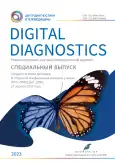Artificial intelligence in the diagnosis of thoracic aortic aneurysms in a retrospective chest computed tomography scan analysis
- Авторлар: Solovev A.V.1,2, Sinitsyn V.E.1,3,4, Petraikin A.V.1, Vladzymyrskyy A.A.1, Reshetnikov R.V.1
-
Мекемелер:
- Moscow Center for Diagnostics and Telemedicine
- Morozovskaya Children’s City Clinical Hospital
- I.V. Davydovsky City Clinical Hospital
- Lomonosov Moscow State University
- Шығарылым: Том 4, № 1S (2023)
- Беттер: 122-124
- Бөлім: Conference proceedings
- URL: https://journals.rcsi.science/DD/article/view/147694
- DOI: https://doi.org/10.17816/DD430366
- ID: 147694
Дәйексөз келтіру
Толық мәтін
Аннотация
BACKGROUND: Aortic aneurysms, known as “silent killers”, are frequently asymptomatic, leading to vessel rupture and death. Annual rates for ruptures, stratifications, and sudden deaths are up to 3.6%, 3.7%, and 10.8%, respectively. Timely diagnosis and early treatment save a patient’s life. The use of artificial intelligence (AI) technologies helps to detect aortic aneurysms, which significantly improves the quality of diagnosis and saves patients’ lives.
AIM: To assess the efficiency of using AI technologies to detect thoracic aortic aneurysms on chest computed tomography (CT) and determining the possibility of using AI technologies as an assistant to the radiologist during the primary description of radiological images.
METHODS: The study retrospectively assessed the results of AI technologies aimed at detecting thoracic aortic aneurysms on chest CT scans. No contrast enhancement was performed primarily. The sample consisted of 84,405 observations of patients over the age of 18 years; of these, 86 scans with thoracic aortic aneurysms were selected according to AI data. The selected examinations were retrospectively assessed by radiologists and vascular surgeons for the probable presence of a thoracic aortic aneurysm. In 44 cases, an aortic aneurysm was initially detected by the radiologist. In 31 cases, an aneurysm was not initially described by the radiologist, 6 were excluded from the sample (due to the absence of the radiologist’s report in the Unified Radiological Information Service), and 5 scans had false-positive results according to AI findings.
RESULTS: The use of AI technologies allows detection and labeling of pathological changes in the aorta on the images. AI technologies increase the detectability of thoracic aortic aneurysms in the description of chest CT scans by 38.8%. The incidence of ascending aortic aneurysm was 0.3%, which corresponded to the literature data of 0.16%–1.6%. According to the results, 22 surgical interventions for aortic stenting were performed.
CONCLUSIONS: The use of AI in the primary chest CT description may help increase the detectability of clinically significant pathological conditions, such as thoracic aortic aneurysm. Further development of routing for this category of patients in the cito mode for surgical treatment is relevant. Expansion of retrospective screening by chest CT scans using AI systems will improve the quality of diagnosis of concomitant pathologies and prevent adverse outcomes for patients.
Негізгі сөздер
Толық мәтін
##article.viewOnOriginalSite##Авторлар туралы
Alexander Solovev
Moscow Center for Diagnostics and Telemedicine; Morozovskaya Children’s City Clinical Hospital
Хат алмасуға жауапты Автор.
Email: atlantis.92@mail.ru
ORCID iD: 0000-0003-4485-2638
SPIN-код: 9654-4005
Ресей, Moscow; Moscow
Valentin Sinitsyn
Moscow Center for Diagnostics and Telemedicine; I.V. Davydovsky City Clinical Hospital; Lomonosov Moscow State University
Email: vsini@mail.ru
ORCID iD: 0000-0002-5649-2193
SPIN-код: 8449-6590
MD, Dr. Sci. (Med.), Professor
Ресей, Moscow; Moscow; MoscowAlexey Petraikin
Moscow Center for Diagnostics and Telemedicine
Email: alexeypetraikin@gmail.com
ORCID iD: 0000-0003-1694-4682
SPIN-код: 6193-1656
MD, Dr. Sci. (Med.)
Ресей, MoscowAnton Vladzymyrskyy
Moscow Center for Diagnostics and Telemedicine
Email: a.vladzimirsky@npcmr.ru
ORCID iD: 0000-0002-2990-7736
SPIN-код: 3602-7120
Ресей, Moscow
Roman Reshetnikov
Moscow Center for Diagnostics and Telemedicine
Email: reshetnikov@fbb.msu.ru
ORCID iD: 0000-0002-9661-0254
SPIN-код: 8592-0558
Ресей, Moscow
Әдебиет тізімі
- Lavall D, Schäfers HJ, Böhm M, Laufs U.: Aneurysms of the ascending aorta. Dtsch Arztebl Int. 2012;109(13):227–233. doi: 10.3238/arztebl.2012.0227
- Elefteriades JA. Natural history of thoracic aortic aneurysms: indications for surgery, and surgical versus nonsurgical risks. Ann Thorac Surg. 2002;74(5):S1877–S1880. doi: 10.1016/s0003-4975(02)04147-4
- Kumar Y, Hooda K, Li S, et al. Abdominal aortic aneurysm: pictorial review of common appearances and complications. Ann Transl Med. 2017;5(12):256. doi: 10.21037/atm.2017.04.32
- Pokrovskii AV. Zabolevaniya aorty i ee vetvei. Moscow: Meditsina; 1979. 326 p.
- Irtyuga OB, Gavrilyuk ND, Voronkina IV, et al. Pathogenetic mechanisms of ascending aortic aneurysm of varied aetiology. Russian Journal of Cardiology. 2013;99(1):14–18.
Қосымша файлдар









